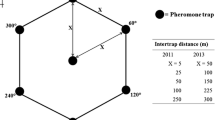Abstract
Studies were conducted to determine the effects of sex pheromone dosage and lure age on movement of male sweetpotato weevils (SPW),Cylas formicarius elegantulus (Summers), using mark-release-recapture techniques. SPW trap counts from various downwind distances were compared for dosages ranging from 0.01 to 10.0 μg and lure ages ranging from fresh (0 days old) to 64 days old. The percentages of male SPW recaptured decreased with an increase in release distance and decreased with a decrease in dosage at each corresponding distance. Most SPW were caught within the first 16-hr period. Slopes of percent recapture vs. release distance for the two higher dosages (10 μg and 1.0 μg) differed from those of the two lower dosages (0.1 and 0.01 μg) but did not differ from each other. Intercepts were similar among the three higher dosages. Slopes did not differ among the five lure ages examined. Intercepts differed between fresh (0 days old) and 24-day-old septa at 16 hr and between fresh (0 days old) and 34-day-old septa at 40 hr. Previous exposure to pheromone (conditioning) did not increase percentages of SPW recaptured. Results indicate that male SPW are capable of traversing distances of at least 280 m in 16 hr. The pheromone tested in this study appears to be effective at dosages lower than any other coleopteran sex-pheromone system. Incorporation of this pheromone into a SPW management system may effectively reduce the use of insecticides.
Similar content being viewed by others
References
Baker, T.C., andRoelofs, W.L. 1981. Initiation and termination of oriental fruit moth male response to pheromone concentrations in the field.Environ. Entomol. 10:211–218.
Cockerham, K.L.,Deen, O.T.,Christian, M.B., andNewson, L.D. 1954. The biology of the sweet potato weevil.La. Tech. Bull. 483. 30 pp.
Coffelt, J.A., andBurkholder, W.E. 1972. Reproductive biology of the cigarette beetle,Lasioderma serricorne. 1. Quantitative laboratory bioassay of the female sex pheromone from females of different ages.Ann. Entomol. Soc. Am. 65:447–450.
Coffelt, J.A., Vick, K.W., Sower, L.L., andMcClellan, W.T. 1978. Sex pheromone of the sweetpotato weevil,Cylas formicarius elegantulus: Laboratory bioassay and evidence for a multicomponent system.Environ. Entomol. 7:756–758.
Davich, T.B., Hardee, D.D., andJesus Alcala, M. 1970. Long-range dispersal of boll weevils determined with wing traps baited with males.J. Econ. Entomol. 63:1706–1708.
Deen, O.T. 1940. Observations on flight of the sweetpotato weevil.La. Agric. Exp. Stn. Bull. 323:40–41.
Hardee, D.D., McKibben, G.H., Rummel, D.R., Huddleston, P.M., andCoppedge, J.R. 1974. Response of boll weevils to component ratios and doses of the pheromone, grandlure.Environ. Entomol. 3:135–138.
Heath, R.R., Coffelt, J.A., Sonnett, P.E., Proshold, F.I., Dueben, B., andTumlinson, J.H. 1986. Identification of sex pheromone produced by female sweetpotato weevil,Cylas formicarius elegatulus (Summers).J. Chem. Ecol. 12:1489–1503.
Heath, R.R., Coffelt, J.A., Proshold, F.I., Jansson, R.K., andSonnett, P.E. 1990. Sex pheromone of sweetpotato weevil: History and implications of chemistry in weevil management,in R.K. Jansson and K.V. Raman (eds.). Sweet Potato Pest Management: A Global Perspective. Westview, Boulder, Colorado. In press.
Jansson, R.K., andHeath, R.R. 1990. Development of a sex pheromone monitoring system for sweetpotato weevil management, pp. 543–552,in R. Howeler (ed.). Proceedings 8th Symposium of the International Society for Tropical Root Crops. CIAT, Bangkok, Thailand. 712 pp.
Jansson, R.K., Heath, R.R., andCoffelt, J.A. 1989. Temporal and spatial patterns of sweetpotato weevil (Coleoptera: Curculionidae) counts in pheromone-baited traps in white-fleshed sweet potato fields in southern Florida.Environ. Entomol. 18:691–697.
Jansson, R.K.,Proshold, F.I.,Mason, L.J.,Heath, R.R., andLecrone, S.H. 1990. Monitoring sweetpotato weevil (Coleoptera: Curculionidae) with sex pheromone: Effects of dosage and age of septa.Trop. Pest Manage. In press.
Johnson, W.L., Cross, W.H., andMcGovern, W.L. 1976. Long-range dispersal of marked boll weevils in Mississippi during 1974.Ann. Entomol. Soc. Am. 69:421–422.
Karandinos, M.G. 1974. Recovery ofSynanthedon pictipes males released at various distances downwind of sex pheromone traps.Environ. Entomol. 3:932–925.
Kehat, M., Navon, A., andGreenberg, S. 1976. Capture of markedSpodoptera littoralis (Boisd). male moths in virgin female traps: Effects of wild male population, distance of traps from release point, and wind.Phytoparasitica 4:77–83.
Kishaba, A.N., Toba, H.H., Wolf, W.W., andVial, P.V. 1970. Response of laboratory-reared male cabbage looper to synthetic sex pheromone in the field.J. Econ. Entomol. 63:178–181.
Neter, J., andWasserman, W. 1974. Applied Linear Statistical Models, R.D. Irwin, Inc. Homewood, Illinois. 842 pp.
Proshold, F.I., Gonzalez, J.L., Asencio, C., andHeath, R.R. 1986. A trap for monitoring the sweetpotato weevil (Coleoptera: Curculionidae) using pheromone or live females as bait.J. Econ. Entomol. 79:641–647.
Schlyter, F., Lofqvist, J., andByers, J.A. 1987. Behavioural sequence in the attraction of the bark beetleIps typographus to pheromone sources.Physiol. Entomol. 12:185–196.
Shorey, H.H., andGaston, L.K. 1964. Sex pheromone of noctuid moths. III. Inhibition of male response to the sex pheromone inTrichoplusia ni (Lepidoptera: Noctuidae).Ann. Entomol. Soc. Am. 57:775–779.
Wall, C., andPerry, J.N. 1987. Range of action of moth sex-attractant sources.Entomol. Exp. Appl. 44:5–14.
Author information
Authors and Affiliations
Rights and permissions
About this article
Cite this article
Mason, L.J., Jansson, R.K. & Heath, R.R. Sampling range of male sweetpotato weevils (Cylas formicarius elegantulus) (Summers) (Coleoptera: Curculionidae) to pheromone traps: Influence of pheromone dosage and lure age. J Chem Ecol 16, 2493–2502 (1990). https://doi.org/10.1007/BF01017472
Received:
Accepted:
Issue Date:
DOI: https://doi.org/10.1007/BF01017472




